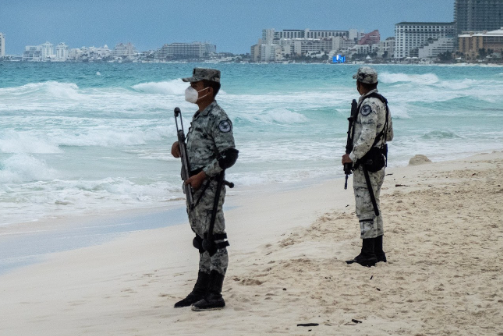Written by Ashley Slud
A trip to Mexico with delicious food, drinks and relaxing beaches – what could go wrong? Well unfortunately, a lot. Within the past 20 years, there has been a large increase in the number of homicides and drug-violence related crime in Mexico. The two tourism spots that this paper will analyze are Cancún and Playa del Carmen, as these are two of the most popular destinations for travelers (López, Statista).
As of April 2022, Cancún has a moderate level of crime at 59.80, and a high rate of crime increasing within the past 3 years (74.32). In just 2021 and 2022, there were 337 murders in Cancún with a homicide rate of 36.81 per 100,000. The global average is around 6 per 100,000. (Cuse, Cancun Sun). The vacation spot has unfortunately moved up to number thirty-six in the top fifty most dangerous cities in the world, from number forty last year. Just recently, in the beginning of 2022 in January, several gunmen killed the manager of a beachside club in Playa del Carmen during the day (Córdoba and Luhnow, Wallstreet Journal). In early February, there were reports of a man being killed on a path near Laguna Manati, a natural area on the outskirts of Cancún. This occurred at the same time as “at least 15 gunshots from an AK-47 were fired at a house in that state and a reporter was nearly gunned down in the town of Isla Mujeres” (Cruz, Agencia Efe). Additionally, in mid-March 2022, tourists on a beach in the hotel zone in Cancún found a spinal cord, a femur and a part of a pelvis. After examination, police forces believe the remains may be linked to an organized crime (Córdoba and Luhnow, Wallstreet Journal).
Quintana Roo, the Mexican State where Cancún is located, is also home to Playa del Carmen, the islands of Cozumel and Isla Mujeres, and other towns. In Quintana Roo, the tourism industry is the main source of revenue in their economies. In fact, tourism accounts for 87% of their GDP (Valenzuela & Tendian, StoryMaps). Drug distribution is a major issue in Quintana Roo as well. Drug cartels cater items such as Mexican-grown cannabis, Colombian pot, or other local drugs to tourists, as it is much easier and cheaper for the cartels, eliminating the risks of crossing the border. Tourists are also more likely to try these drugs, as they are not able to have access to them in their respective homes. Drugs are also sold openly in club bathrooms, and cartels often place dealers inside of restaurants. The club and restaurant owners don’t go to the authorities because they are scared of the gang’s response (Malkin, NY Times). The popularity of drugs has contributed to the increase in the number of homicides in Mexico. Homeless people or other locals on the street may try to sell drugs to tourists, and if the tourists aren’t interested, they may be scared off and deterred from ever going to the destination again.
Government officials are trying to get ahead of the problem so that the state does not become like Acapulco, a beach resort town on Mexico’s Pacific Coast which had previously been the murder capital of the world due to cartel feud. For instance, state and federal officials have “increased the number of state police to 1,500 officers. [They have added] around 2,500 new security cameras along the coast, some with facial recognition technology, [which] have helped authorities make arrests” (Córdoba and Luhnow, Wallstreet Journal). Informal police tents are also being set up every few kilometers with Mexico National Guard members and police, in order to bolster security and decrease crime along these areas.
So what do these incidences of homicide, and other dangerous events mean for the industry that truly supports the livelihood of the countries? The 2018 Mexico Peace Index (MPI) shows that the economic impact of crime and violence to the Mexican government amounted to 4.72 trillion pesos (US $249 billion) in 2017, which is 21% of the country’s GDP. Homicide made up 46% of this impact. The tourism industry consists of many micro enterprises, which includes many family-owned businesses that employ fewer than ten people. These companies could be restaurants, art shops, gift-shops, etc. With the spike in crime, these micro businesses have to cancel growth plans, must reduce working schedules, and cancel distribution routes. Decreases in desire to travel to Mexico can severely harm these families’ income that rely almost entirely on tourists (Saborowski, World Economic Forum). In order for Mexico to improve both the safety of their residents and tourists, and the stability of their economy, they must continue allocating resources and time into protection and security against these crimes. It is critical for Mexico’s crime rates to decrease, as their economy relies so heavily on tourism that locals truly cannot survive a major loss in visitors.
“Crime Wave in Mexico’s Caribbean Region Prompting Tourism Concerns.” Www.efe.com, 4 Feb. 2022, https://www.efe.com/efe/english/world/crime-wave-in-mexico-s-caribbean-region-prompting-tourism-concerns/50000262-4732582.
Cruse, Author Steven. “Cancun Joins 7 U.S. Cities on Top 50 Most Dangerous in the World.” Cancun Sun, 10 Mar. 2022, https://thecancunsun.com/cancun-joins-7-u-s-cities-on-top-50-most-dangerous-in-the-world/#:~:text=Cancun%20saw%20337%20murders%20in,the%20presence%20of%20organized%20crime.
José de Córdoba, David Luhnow. “Cancún’s Tourist Idyll Is Shattered by Drug Violence and Homicides.” The Wall Street Journal, Dow Jones & Company, 3 Apr. 2022, https://www.wsj.com/articles/cancun-tulum-riviera-maya-mexico-drugs-homicides-11648853578 López, Ana M. “Top Tourist Destinations in Mexico.” Statista, 21 Sept. 2021, https://www.statista.com/statistics/1135858/leading-tourist-destinations-mexico/#:~:text=Mexico%20City%20was%20the%20leading,visitor%20arrivals%20that%20same%20year
Malkin, Elisabeth. “Along Mexico’s Riviera Maya, Tourists, Drugs and Violence.” The New York Times, The New York Times, 25 Feb. 2022, https://www.nytimes.com/2022/02/25/travel/cancun-tulum-mexico-shooting.html.
Martina Valenzuela, Nadia Tendian &. “A Recipe for Disaster: Planned Tourism Development in México.” ArcGIS StoryMaps, Esri, 19 May 2021, https://storymaps.arcgis.com/stories/6b1666acb1634586bfe55a622b738fd8.
Saborowski, Christian. “Here’s How Much Mexico’s Spike in Crime Hurts the Economy.” World Economic Forum, https://www.weforum.org/agenda/2018/12/chart-of-the-week-mexico-s-spike-in-crime-hurts-the-economy.

